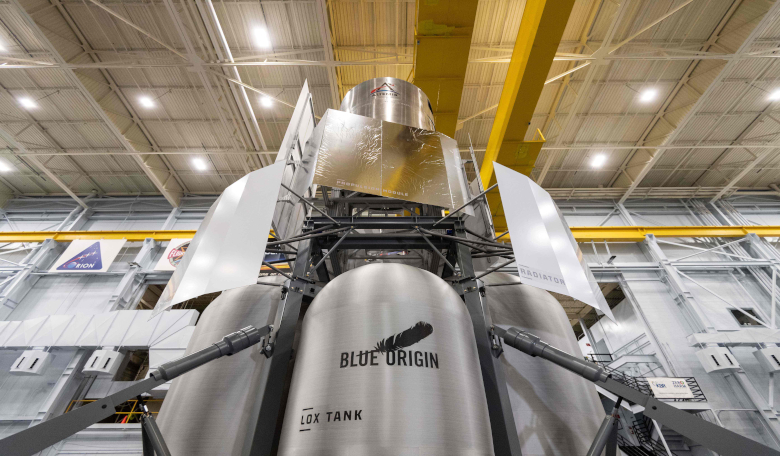NASA is now in possession of a full-scale engineering mockup of a Human Landing System (HLS) – a crew lander vehicle that could one day take astronauts to the Moon – designed by Blue Origin and the members of its “National Team”, as part of the agency's push to return humans to the lunar surface by 2024.
Standing at more than 40 feet tall, the mockup is not a functional version of the lander, but it does include testable full-sized components of the descent and ascent elements that will be constructed by Blue Origin and Lockheed Martin respectively.
The Descent Element is based on the Blue Moon lunar lander and BE-7 LOX/hydrogen engine, while the reusable Ascent Element vehicle is based on the deep-space Orion vehicle that will fly on the Artemis I and II missions.
The team, which also includes Northrop Grumman and Draper, were selected by NASA earlier this year to develop the Integrated Lander Vehicle (ILV) – a three-stage lander to be launched on Jeff Bezos’s own New Glenn Rocket System.
Northrop Grumman will be providing the “Transfer Element”; a vehicle that brings the landing systems into position in lunar orbit.
The Transfer Element is based on its Cygnus cargo module, which is used to carry crew supplies, spare equipment and scientific experiments to the space station.
The space pioneering firm are also designing and building the Habitation and Logistics Outpost, or HALO, module for NASA's proposed Lunar Gateway which will serve as an exploration outpost for lunar missions.
Meanwhile Draper, who built the guidance computer for the Apollo program, will lead development of the descent guidance system, as well provide flight avionics.
“Each partner brings its own outstanding legacy to the National Team. These include developing, integrating, and operating human-rated spacecraft, launch systems and planetary landers. Together we form an excellent team to send our next astronauts to the Moon in 2024,” said Kirk Shireman, vice president of Lunar Campaigns at Lockheed Martin Space.
With the mock-up now ready for evaluation, NASA organisations including JSC’s Astronaut Office can begin crew operations tests.
“Testing this engineering mockup for crew interaction is a step toward making this historic mission real,” said Brent Sherwood, vice president of Advanced Development Programs, Blue Origin. “The learning we get from full-scale mockups can’t be done any other way.”
The mockup will remain at NASA Johnson Space Center (JSC) through early 2021 so that the National Team can refine the landers design as they work towards constructing the final production model.
“Augmenting state of the art tools with physically being able to see, interact, and evaluate a full-up lander in person is critical,” added Shireman. “It will inform our design and requirements earlier in the program allowing us to accelerate our development and meet the 2024 lunar landing goal.”
Two other US companies, SpaceX and Dynetics, were also chosen to design and develop Human Landing Systems for the NASA's Artemis program; the total combined value for all awarded contracts was $967 million for the 10-month base period.











